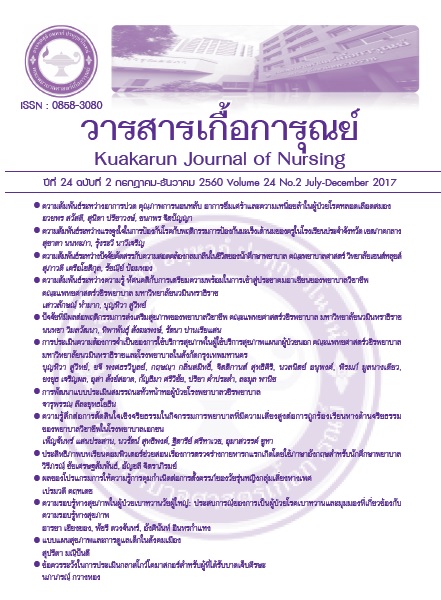ความสัมพันธ์ระหว่างอาการปวด คุณภาพการนอนหลับ อาการซึมเศร้า และความเหนื่อยล้าในผู้ป่วยโรคหลอดเลือดสมอง
คำสำคัญ:
อาการปวด, คุณภาพการนอนหลับ, อาการซึมเศร้า, ความเหนื่อยล้า, โรคหลอดเลือดสมองบทคัดย่อ
บทคัดย่อ
การวิจัยแบบสหสัมพันธ์เชิงพรรณนาครั้งนี้มีวัตถุประสงค์เพื่อศึกษาความเหนื่อยล้าในผู้ป่วย โรคหลอดเลือดสมองและศึกษาความสัมพันธ์ระหว่างปัจจัยคัดสรร ได้แก่ อาการปวด คุณภาพ
การนอนหลับ อาการซึมเศร้าและความเหนื่อยล้าในผู้ป่วยโรคหลอดเลือดสมอง โดยใช้แนวคิดความเหนื่อยล้าของไปเปอรเ์ ป็นกรอบแนวคิดการวิจัย กลมุ่ ตัวอยา่ งคือ ผ้ปู ่วยโรคหลอดเลือดสมองจำนวน 140 คน ที่เข้ารับการรักษาในแผนกผู้ป่วยนอกโรงพยาบาลตติยภูมิสามแห่ง คัดเลือกกลุ่มตัวอย่างด้วยวิธีสุ่มอย่างง่าย เครื่องมือที่ใช้ในการวิจัย ได้แก่ แบบสอบถามข้อมูลทั่วไปและข้อมูลการเจ็บป่วย แบบประเมินอาการปวด แบบประเมินคุณภาพการนอนหลับแบบประเมินอาการซึมเศร้า และแบบประเมินความเหนื่อยล้า เครื่องมือวิจัยผ่านการตรวจสอบความตรงตามเนื้อหา โดยผู้ทรงคุณวุฒิ 5 คน ทดสอบความเที่ยงของเครื่องมือโดยใช้สูตรสัมประสิทธิ์แอลฟาครอนบาค มีค่าความเที่ยงเท่ากับ .61, .84 และ .92 หาค่าความถี่ ร้อยละ ค่าเฉลี่ย ส่วนเบี่ยงเบนมาตรฐานและสถิติสัมประสิทธิ์สหสัมพันธ์เพียร์สันในการวิเคราะห์ข้อมูล
ผลการวิจัยพบว่า
1. กลุ่มตัวอย่างผู้ป่วยโรคหลอดเลือดสมองมีคะแนนเฉลี่ยความเหนื่อยล้าเท่ากับ 4.03 (S.D = 1.43) โดยพบว่ากลุ่มตัวอย่างร้อยละ 55.70 รายงานความเหนื่อยล้า2. อาการปวด คุณภาพการนอนหลับและอาการซึมเศร้ามีความสัมพันธ์ทางบวกกับความเหนื่อยล้าในผู้ป่วยโรคหลอดเลือดสมองอย่างมีนัยสำคัญทางสถิติที่ระดับ.01 (r =.35, r = .53, r = .56)
เอกสารอ้างอิง
ธนา นิลชัยโกวิทย์, มาโนช หล่อตระกูล, และ อุมาภรณ์ ไพศาลสุทธิเดช. (2539). การพัฒนาแบบสอบถาม Hospital Anxiety and Depression Scale ฉบับภาษาไทยในผู้ป่วยโรคมะเร็ง.
วารสารสมาคมจิตแพทย์แห่งประเทศไทย, 41(1), 18-30.
มาโนช หล่อตระกูล. (2544). เครื่องมือประเมินปัญหาสุขภาพจิตและจิตเวช. สืบค้นเมื่อ 14 กุมภาพันธ์ 2557,จาก http://www.ramamental.com/gp/gp31.
สมศักดิ์ เทียมเก่า, ชูศรี คูชัยสิทธิ์, สุกานดา อริยานุชิตกุล, ศศิธร แสงพงศานนท์, สุพจน์ คำสะอาด และ วาสนา จันทะชุม. (2552). คุณภาพชีวิตของผู้ป่วยนอกโรคหลอดเลือดสมอง
ที่โรงพยาบาลศรีนครินทร์. จดหมายเหตุทางแพทย์ แพทยสมาคมแห่งประเทศไทยในพระบรมราชูปถัมภ์, 92(12), 1602-1609.
สมาคมการศึกษาเรื่องความปวดแห่งประเทศไทย.(2552). แนวทางพัฒนาการระงับปวดเฉียบพลัน (Clinical Guidance for Acute Pain Management) (Vol.1). กรุงเทพฯ:
สมาคมการศึกษาเรื่องความปวดแห่งประเทศไทย.
สำนักโรคไม่ติดต่อ กรมควบคุมโรค. (2557). จำนวนและอัตราการตายด้วยโรคหลอดเลือดสมอง ปี 2544 - 2555. สืบค้นเมื่อ 14 กุมภาพันธ์ 2557, จาก http://thaincd.com/informationstatistic/non-communicable-disease-data.php,
Acciarresi, M., Bogousslavsky, J., & Paciaroni, M. (2014). Post-stroke fatigue: Epidemiology, clinical characteristics and treatment. Eur Neurol, 72(5-6), 255-261.
Bassetti, C. L., & Hermann, D. M. (2011). Sleep and stroke. Handb Clin Neurol, 99, 1051-1072.
Cumming, T. B., Thrift, A. G., Collier, J. M., Churilov, L., Dewey, H. M., Donnan, G. A., & Bernhardt, J. (2011). Very early mobilization after stroke fast-tracks return to
walking: Further results from the phase II AVERT randomized controlled trial. Stroke, 42(1), 153-158.
Davis , S., & Norrving, B. (2013). Organizational Update: World Stroke Organization. Stroke, 44(12), e173.
De Groot, M. H., Phillips, S. J., & Eskes, G. A. (2003). Fatigue associated with stroke and other neurologic conditions: Implications for stroke rehabilitation. Arch Phys Med
Rehabil, 84(11), 1714-1720.
Eilertsen, G., Ormstad, H., & Kirkevold, M. (2013). Experiences of poststroke fatigue: Qualitative meta-synthesis. J Adv Nurs, 69, 514-525.
Giacobbe, P. (2010). Post-stroke fatigue: Refining the concept. (Master of Science), University of Toronto, Retrieved from http://books.google.co.th/
books?id=iUk5MwEACAAJ
Krupp, L., LaRocca, N., Muir-Nash, J., & Steinberg, A. (1989). The fatigue severity scale. Application to patients with multiple sclerosis and systemic lupus erythematosus.
Arch Neurol, 46, 1121 - 1123.
Lerdal, A., & Gay, C. L. (2013). Fatigue in the acute phase after first stroke predicts poorer physical health 18 months later. Neurology, 1-7.
Mohsenin, V. (2001). Sleep-related breathing disorders and risk of stroke. Stroke, 32(6), 1271-1278.
Naess, Lunde, L., & Brogger, J. (2012). The effects of fatigue, pain, and depression on quality of life in ischemic stroke patients: The Bergen stroke study. Vasc Health Risk
Manag, 8, 407-413.
Naess, Lunde, L., Brogger, J., & Waje-Andreassen, U. (2010). Post-stroke pain on long-term follow-up: The Bergen stroke study. J Neurol, 257(9), 1446-1452.
Naess, H., Lunde, L., Brogger, J., & Waje-Andreassen, U. (2012). Fatigue among stroke patients on long-term follow-up: The Bergen stroke study. J Neurol Sci, 312(1-2),
138-141.
Naess, H., & Nyland, H. (2013). Poststroke fatigue and depression are related to mortality in young adults: A cohort study. BMJ Open, 3
Piper, B. F. (1993). Fatigue and cancer: Inevitable companions? Supportive Care in Cancer, 1(6), 285-286.
Thondike, R. (1979). Correlation procedures for research. Gardner Press, Inc., New York 1978. Biometrical Journal, 21(4), 403-403.
van de Port, I. G., Kwakkel, G., Schepers, V. P., Heinemans, C. T., & Lindeman, E. (2007). Is fatigue an independent factor associated with activities of daily living,
instrumental activities of daily living and health-related quality of life in chronic stroke? Cerebrovasc Dis, 23(1), 40-45.
Wang, S. S., Wang, J. J., Wang, P. X., & Chen, R. (2014). Determinants of fatigue after First-ever ischemic stroke during acute phase. PLoS One, 9(10), e110037.















